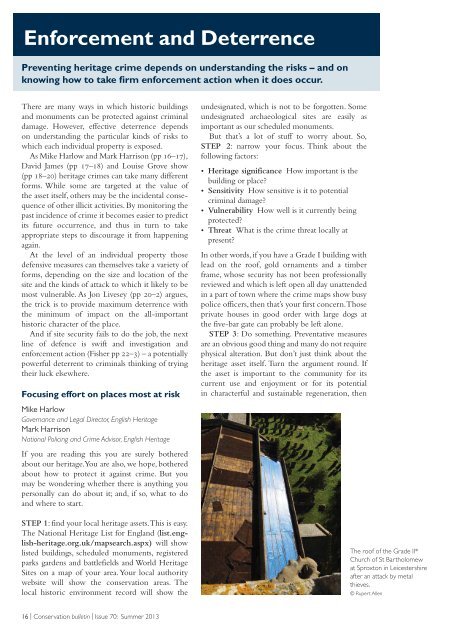Conservation Bulletin 70 | PDF - English Heritage
Conservation Bulletin 70 | PDF - English Heritage
Conservation Bulletin 70 | PDF - English Heritage
Create successful ePaper yourself
Turn your PDF publications into a flip-book with our unique Google optimized e-Paper software.
Enforcement and Deterrence<br />
Preventing heritage crime depends on understanding the risks – and on<br />
knowing how to take firm enforcement action when it does occur.<br />
There are many ways in which historic buildings<br />
and monuments can be protected against criminal<br />
damage. However, effective deterrence depends<br />
on understanding the particular kinds of risks to<br />
which each individual property is exposed.<br />
As Mike Harlow and Mark Harrison (pp 16–17),<br />
David James (pp 17–18) and Louise Grove show<br />
(pp 18–20) heritage crimes can take many different<br />
forms. While some are targeted at the value of<br />
the asset itself, others may be the incidental consequence<br />
of other illicit activities. By monitoring the<br />
past incidence of crime it becomes easier to predict<br />
its future occurrence, and thus in turn to take<br />
appropriate steps to discourage it from happening<br />
again.<br />
At the level of an individual property those<br />
defensive measures can themselves take a variety of<br />
forms, depending on the size and location of the<br />
site and the kinds of attack to which it likely to be<br />
most vulnerable. As Jon Livesey (pp 20–2) argues,<br />
the trick is to provide maximum deterrence with<br />
the minimum of impact on the all-important<br />
historic character of the place.<br />
And if site security fails to do the job, the next<br />
line of defence is swift and investigation and<br />
enforcement action (Fisher pp 22–3) – a potentially<br />
powerful deterrent to criminals thinking of trying<br />
their luck elsewhere.<br />
Focusing effort on places most at risk<br />
Mike Harlow<br />
Governance and Legal Director, <strong>English</strong> <strong>Heritage</strong><br />
Mark Harrison<br />
National Policing and Crime Advisor, <strong>English</strong> <strong>Heritage</strong><br />
If you are reading this you are surely bothered<br />
about our heritage.You are also, we hope, bothered<br />
about how to protect it against crime. But you<br />
may be wondering whether there is anything you<br />
personally can do about it; and, if so, what to do<br />
and where to start.<br />
STEP 1: find your local heritage assets.This is easy.<br />
The National <strong>Heritage</strong> List for England (list.english-heritage.org.uk/mapsearch.aspx)<br />
will show<br />
listed buildings, scheduled monuments, registered<br />
parks gardens and battlefields and World <strong>Heritage</strong><br />
Sites on a map of your area.Your local authority<br />
website will show the conservation areas. The<br />
local historic environment record will show the<br />
undesignated, which is not to be forgotten. Some<br />
undesignated archaeological sites are easily as<br />
important as our scheduled monuments.<br />
But that’s a lot of stuff to worry about. So,<br />
STEP 2: narrow your focus. Think about the<br />
following factors:<br />
• <strong>Heritage</strong> significance How important is the<br />
building or place?<br />
• Sensitivity How sensitive is it to potential<br />
criminal damage?<br />
• Vulnerability How well is it currently being<br />
protected?<br />
• Threat What is the crime threat locally at<br />
present?<br />
In other words, if you have a Grade I building with<br />
lead on the roof, gold ornaments and a timber<br />
frame, whose security has not been professionally<br />
reviewed and which is left open all day unattended<br />
in a part of town where the crime maps show busy<br />
police officers, then that’s your first concern.Those<br />
private houses in good order with large dogs at<br />
the five-bar gate can probably be left alone.<br />
STEP 3: Do something. Preventative measures<br />
are an obvious good thing and many do not require<br />
physical alteration. But don’t just think about the<br />
heritage asset itself. Turn the argument round. If<br />
the asset is important to the community for its<br />
current use and enjoyment or for its potential<br />
in characterful and sustainable regeneration, then<br />
The roof of the Grade II*<br />
Church of St Bartholomew<br />
at Sproxton in Leicestershire<br />
after an attack by metal<br />
thieves.<br />
© Rupert Allen<br />
16 | <strong>Conservation</strong> bulletin | Issue <strong>70</strong>: Summer 2013

















